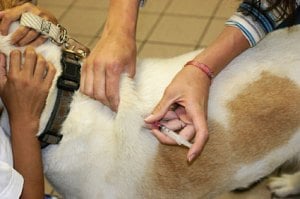Key Takeaways
- Diabetes is common in dogs and more likely in some breeds than others.
- Dogs can develop both Type I and Type II diabetes.
- Symptoms of diabetes in dogs are excessive urination and increased thirst and appetite.
- You can manage your dog’s diabetes at home with insulin shots and blood sugar monitoring.
- Diabetes management in dogs also involves a special diet and consistent exercise routine.
Table of Contents
Diabetes in dogs is a fairly common medical condition. Just as in humans, it’s easily manageable by a caring, organized individual. A diabetic dog is often considered “less adoptable” because of its condition, which scares off many potential pet parents. Although adopting a dog with diabetes may require a little more devotion – managing daily medications and monitoring blood tests – the reward of unconditional love is well worth it.

Causes of Diabetes in Dogs
There are several factors that can increase a dog’s risk of developing diabetes. Certain breeds of dog are thought to be genetically susceptible to the disease, including Poodles, Dachshunds, Beagles, and Miniature Schnauzers. Pancreatitis in dogs and autoimmune diseases like lupus can increase a dog’s chance of developing the condition. Senior dogs, overweight dogs, and females also face a higher risk of diabetes.
There are two forms of diabetes in dogs:
- Type I, called insulin-dependent diabetes, is caused by a shortage of insulin, which regulates blood sugar. This condition requires supplementary insulin shots and is the most common form of the disease in dogs.
- Type II, known as insulin-resistant diabetes, is more frequently seen in cats. Some insulin production remains, although it may be too high or low for the animal’s health.

Symptoms of Diabetes in Dogs
Increased thirst and appetite, excessive urination, and weight loss are all signs consistent with a diagnosis of diabetes in dogs. However, because this combination of clinical signs can also be caused by other medical conditions, diagnostic blood work and urinalysis need to be performed to confirm a diagnosis. Making regular appointments with your vet can help detect symptoms early and prevent the disease from progressing. A general rule of thumb: adult dogs should be seen by a veterinarian once a year, barring emergencies, and senior dogs – those six to ten years old and up – need a veterinary exam every six months.
It can be difficult to discern dog diabetes symptoms: How much water is too much? Most vets agree that dogs, just like humans, need to drink one fluid ounce of water per pound of weight. Dog water bowls typically hold eight to sixteen ounces; a Chihuahua would drink less than one bowl, while a Labrador may need up to five bowls, depending on their size). As for potty breaks, three to five per day is normal. If you notice your pup constantly has to pee and is drinking more water than normal, it would be wise to have some diagnostics performed with your veterinarian.
Dog Diabetes Diagnosis and Treatment
The veterinarian will compile a detailed medical history of your pet’s symptoms, including when they began and any unusual changes in appetite, behavior, or bathroom habits. Blood and urine tests generally indicate a diagnosis of diabetes right away; unusually high levels of glucose will be found in both.
After Diagnosis – Finding Your Dog’s Insulin Dosage
After diagnosis, the first step towards treating diabetes in dogs is testing blood glucose (sugar) levels. The veterinarian will measure your pet’s blood sugar over a period of 12 to 24 hours, creating what is known as a “glucose curve.” This process often requires an overnight stay at the clinic while your vet compares the curve to your dog’s feeding and insulin injection times. These initial tests determine the insulin dosage your dog needs and establish a baseline for blood sugar levels.
Be aware that symptoms of diabetes in dogs can reoccur or worsen over time; multiple adjustments to insulin dosage may be needed, especially in the disease’s early stage. If different insulin products or different doses are being tried, several glucose curves may need to be performed. Once your vet has determined the appropriate dosage of insulin for your dog’s size, age, gender, and activity level, the next step is beginning treatment.
At-Home Canine Diabetes Management
Managing your dog’s diabetes is doable. The goal of canine diabetes treatment is to stabilize blood sugar (glucose) levels with insulin shots. A strict daily regimen for regular feeding, blood sugar monitoring, and insulin injections can prevent and control unpleasant symptoms of the disease. Read on for tips on how to manage diabetes in dogs!
A diet plan will be created by your vet for both underweight and overweight pets; obesity and anorexia can complicate diabetes. It’s essential for pet parents to keep careful track of their pet’s diet, weight, glucose test results, and daily insulin dosage. Your veterinarian will select a type and dosage frequency of insulin that meets your dog’s needs and instruct you on delivering insulin shots if needed. Diabetes is a chronic condition that cannot be cured but is manageable with dedication and organization.
Administering Insulin
One of the most difficult challenges for pet parents of a diabetic dog can be the daily insulin injections. It may seem intimidating at first, but the “ordeal” is actually quick and relatively painless if done properly. Your veterinarian will go over the insulin injection process with you, demonstrating how to measure out the correct dosage and where to administer the shot. Avoid using the same spot repeatedly; vary the injection site daily. Never change the dose of insulin you are giving to your dog without getting the OK from your veterinarian.
Insulin for dogs must be kept refrigerated and out of paws’ reach. The small, clear vials can appear similar to airplane bottles or condiments, so it’s wise to place them in a clearly-marked container. Needles and other supplies for diabetes in dogs should be stored in a dog-proof place as well.

Testing Blood Glucose
Most pet parents use AlphaTrack to monitor their pet’s blood glucose. Veterinarians usually recommend that pet parents take blood from the rim of the dog’s ear. If that is too difficult, some people take it from the spot near the toes on the pet’s back feet, but on a non–weight-bearing pad to limit discomfort. Pet parents may want to vary where they take the blood so it’s not in the same area twice a day.
A Daily Routine
One of the most important parts of managing diabetes is sticking to a routine – breakfast, and dinner at the same time every day, and insulin to correspond with those times. The vet’s office should provide clear, written instructions that include the schedule, what blood glucose readings are concerning, and when to seek help from the vet.
Stick to a Diabetic Dog Food Diet
Avoiding fatty foods is key for a diabetic dog. Your vet will prescribe diabetic dog food that is high in fiber, high in protein, and low in carbohydrates rather than diets high in fats. Make sure your pup is eating a full meal! Insulin treatment is based on healthy portion sizes; eating more or less may require a change in insulin dosage or skipping a dose. If your dog isn’t eating, it is vital to speak to your veterinarian before giving insulin as you can make them very sick.
Dogs with diabetes are also prone to develop pancreatitis, a painful inflammatory disease thought to be caused by a high-fat diet or sudden exposure to higher fat food. When it comes to dessert, leave the scraps on your plate, not the floor for Fido. Making homemade dog treats is an easy way to know exactly what your pet is eating and to control fat content.
Develop an Exercise Routine
Although exercise is essential for managing diabetes in dogs, it also has an effect on insulin dosage. Work with your vet to create a consistent exercise regimen that works within the treatment plan. Dog exercise needs vary by age, breed, and pre-existing conditions like hip dysplasia. Obese dogs should focus on shedding pounds slowly yet surely, so as not to lower blood sugar too quickly. Healthy pets can go running, walking or play at the dog park – diabetes itself doesn’t limit a dog’s activity level – as long as the exercise is regular. Just as with diet, the amount of exercise can affect the dosage of insulin for a diabetic dog. Always consult your veterinarian when creating an exercise plan for your pet, especially for senior dogs and those with underlying medical conditions.
Watch For Any Changes
Consistency is everything for the management of diabetes in dogs: in exercise, diet, and insulin injections. Even if you religiously stick to your routine, your pet’s insulin needs can change. Signs that your pet isn’t feeling well can develop scarily fast. If your pet has a case of diarrhea or vomiting, blood sugar can drop dangerously. Keep an eye on your diabetic dog for the following warning signs:
- Excessive thirst or hunger
- Urinating more than normal or household potty accidents
- Cloudy eyes (cataracts)
- Sudden weight gain or loss
- Trembling, weakness
- Fainting
- Confusion and lethargy
- Sudden collapse

If any of these signs are seen at home in your diabetic dog, bring your pet to the veterinary hospital right away.
A dog with diabetes who appears confused, weak, or faints may be experiencing hypoglycemia. Vomiting and seizures can occur in extreme cases. Low blood sugar is extremely dangerous for a diabetic dog and is a true medical emergency. Seizures, coma, and even death can occur if hypoglycemia is left untreated in a diabetic dog. Offer the pet food or treats; if refused, honey or Karo syrup must be rubbed on the animal’s gums and tongue to increase their blood sugar level. Do not administer your pet’s usual dose of insulin during a hypoglycemic episode as it can make the hypoglycemia worse. Call your veterinarian at the first sign of hypoglycemia or any other unusual symptoms.
Diabetes Can Cause Other Issues
Diabetes can be a devastating condition, and it affects all of the body’s systems. Pets with diabetes are more prone to complications like high blood pressure, chronic UTIs, hind leg weakness due to low blood potassium (hypokalemia), and eye issues, according to the American Veterinary Medical Association. Cataract surgery and steroid eye drops, the typical treatment for cataracts, comes with the added stress of temporarily making the blood sugar higher. Steroids tend to cause insulin resistance, harbor glucose, and put pressure on the liver to release extra glucose.
Living with Diabetes
Keeping your diabetic pet healthy seems daunting upon the first few days of diagnosis, but pet parents get the hang of it quickly, prioritizing their best buddy’s health overall. Plus, as the AVMA says, with proper monitoring, treatment, and diet, and exercise, diabetic pets can lead long and happy lives. Choosing a diabetic-specific dog food diet, increasing exercise safely, and closely monitoring for any changes in behavior will keep the condition under control.
If your dog should be diagnosed with diabetes, pet insurance can help defray much of the cost. One pet parent of a miniature pinscher who was diagnosed with diabetes at eight years old was able to get much of his care covered by insurance. Her Healthy Paws plan reimbursed her $11,598 for a year’s worth of medication and treatments.
The content is not intended to be a substitute for professional veterinarian advice, diagnosis, or treatment. Always seek the advice of your veterinarian or other qualified health provider with any questions you may have regarding a medical diagnosis, condition, or treatment options.
By enrolling your dog or cat in pet insurance early, vet visits and prescriptions for chronic conditions like diabetes can be covered up to 90%, as long as symptoms show up after your waiting period. Find out more by getting a free quote.









